MOUNT ETNA ( Italy)
European Laboratory Volcano
Etna is one of the largest and most active continental volcanoes on Earth. Since its first activity 500,000 - 700,000 years ago, Etna has grown to cover more than 1,250 square kilometers and, rising to 3,300 m above the sea level, today dominates the eastern coastline of Sicily. Although major eruptions occur on average once every 3-5 years, the volcano has also become a major component in the regional economy, particularly for agriculture and tourism, and more than 25% of the Sicily's population currently resides on its slopes. As a result, even a moderate eruption may have severe economic consequences on local communities. Etna's frequent activity and economic importance thus make it an ideal volcano for simuling researches, developing monitoring and studying associated hazards.
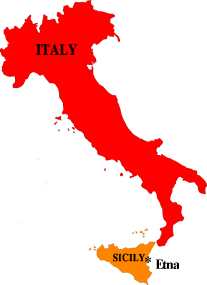
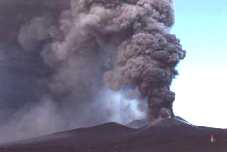
| Eruptive plume - 2750 m vent 2002 - E.Gegoud |
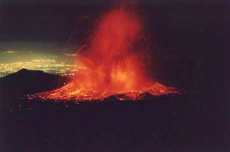
| Eruptive activity from Etna's vent (2002) E.Gegoud |
The Catania Section of the Istituto Nazionale di Geofisicia e Vulcanologia (INGV) has been working for 20 years within geophysical and volcanic research and monitoring of active volcanoes. At the moment, the monitoring devices managed by INGV-CT are represented by permanent networks of remote sensors (seismic, geodetic, magnetic, gravimetric and videos) distributed suitably in, seismic and volcanic Sicilian areas for gathering information about their geodynamic activity. These devices are connected in real time, by radio and/or mobile phone, to the acquisition center in Catania. Data continuously recorded by permanent stations are also integrated by discrete observations, surveys and laboratory analysis to evaluate in real time typology and activity level of the volcano, and consquently to define the pre-alarm/alarm thresholds relevant for civil Protection decision.
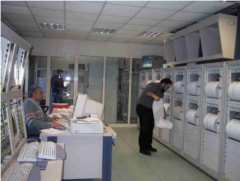
| Ooperations room -seismic recorders (INGV) |
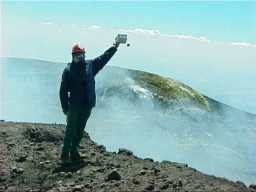
| Gas collected from the summital craters by H.Gaudru for INGV |
Geochemical monitoring programmes currently run by INGV focus on the analysis of tempral changes influx, energy, chemical and isotopic composition of fluids released by italians volcanoes. The acquisition of geochemical data either continuous or discontinuous is presently carried out at Etna. In particular the continuous monitoring of gases and groundwater is integrated by measurements of diffuse soil CO2 degassing, monthly performed with the aim to investigate activity and to evaluate the gas hazards.
In the last 13 years gas emissions from both the summits craters and the flanks of Mount Etna have also been monitored using remote sensing techniques ( COSPEC since 1987; FTIR since 2000) and on-site monitoring devices. The SO2 plume flux from the summit craters has routinely been measured by correlation spectrometry ( COSPEC) from a ground vehicle and, occasionally, from a helicopter. The SO2 flux data allow to estimate the volume of single magma batches that migrate upwards into the volcanic system. Furthermore, FTIR monitoring initiated since mid-2000 have allowed to recognize important variations of SO2/HCl and SO2/HF ratios in the volcanic plume which, combined with COSPEC data provide new insight into the dynamics of ascent and degassing of discrete magma bodies.
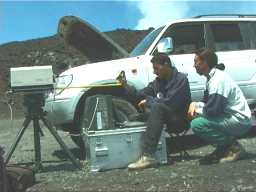
| FTIR measurements F.Mure (INGV) and H.Gaudru (SVE) |
VOLCANIC HAZARDS
Mount Etna volcanic activity mainly consists of nearly continuous degassing from summit craters, strombolian phases of highly variable intensisity, and frequent basaltic lava flows representing a primary source of volcanic hazard in the Etnean region including the large town of Catania where more than 500.000 inhabitants are living. Although Etna lava flows are not very dangerous for the population, wide flank sectors have been covered at least once by lava flows in the last few centuries, sometimes down to low elevations, in the densely urbanized and populated belt between sea level and the 1000 m contour line. In this case, apart from problems related to evacuation of thousands people, even attemps of damage mitigatigation by trying to divert the flow course under proper conditions might prove very difficult as experimented in 1983, 1991-1992.
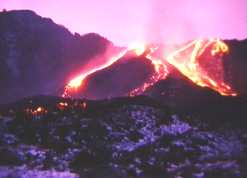
| Lava flows in Val Calanna - December 1991- H.Gaudru |
Other potential hazards
1) Seimic activity connecting with eruptive activity (before, during and after eruption) - Seismic activity can cause serious damage for building and public infrastructure around the volcano and sometimes injuries or fatalities.
2) Gaz plume emission, volcanic dust and ashfalls - High magnitude explosive events at summits craters can also be included among typical eruptive manifestations of the volcano as witnessed in the last decades by the occurence of several paroxysms leading to the formation of eruptive columns up to 10-12 km high. The products from the most intense explosive are a notable source of damage for local cultivations and of risks for vehicular and aircraft in a wide area around the volcano
3) Flank collapse before or following eruption ; gravitational processes. One of the most hazardous processes that can occur at a volcano is a collapse of one of its flanks leading to a huge avalanche of volcanic debris. A such gravitational spreading on Etna could be very devastating.
4) Phréatic and phréatomagmatic eruptions. This activity may potentially jeopardise tourists and scientists approaching the top and flanks of the volcano by bombs and ejecta.
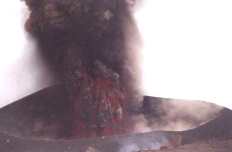
| Phreatomagmatic activity in November 2002 from the eruptive vent 2750 m - E. Gegoud - |
HAZARD ASSESSMENTS ( general view)
The recording historic activity and modern volcano monitoring at the Etna in themselves are however insufficient to fully determine the characteristic behavior of the volcano , because a time record of such information, though perhaps long in human terms, is much too short in geologic time to permit very reliable predictions. Etna's system parameters consist of geochemical, seismic, magnetic, electric, morphological, volcanological and physical and rheological data of rocks, magma, and lava which make up the volcanic system and its geodynamic setting. These data can be also used both for physical modeling of the volcano and statistical analysis to assess future eruptive activity. As on the Etna, volcanic eruptions are a major problem in many developing and developped countries. A large number of communities including megacities grow around and even on active volcanoes exposing the population to volcanic hazards. Although the technology and science can provide adequate warnings to the general populace before an expected eruption , the most effective approach to reducing losses is prevention. In terms both of general (social, financial and economics cost) and individual (social-psychological welfare, material and emotional losses) interests, it's hopeful to rely on preventive actions to decrease risks and their impacts. This is always most effective rather than intervening after the eruptive event, in emergency conditions.
* SVE observation fieldwork 2001 was carried out under the aegis of UNISDR
Some other Websites dedicated to the Etna volcano :
INGV-Catane (official news page for Etna)
B.Behncke - Stromboli on-line - C. Rivière (en français) - T.Pfeiffer